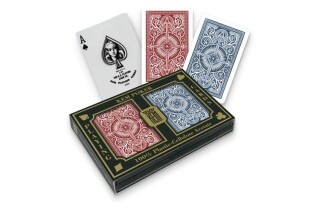Few things are more fun than a great game played with friends and family. While there are so many games available today, from new or classic board games to even video games, the standard deck of cards still offers many possibilities. Players of all ages can learn to play card games like Go Fish and War, and casino classics can even be played at home.
If you have a deck of playing cards lying around, perhaps it’s time to learn a new game for your next game night. Whether you’re looking for family bonding time or are hosting a gathering, these games are sure to be a hit!
Blackjack
The Basics: 2-8 players, one or more deck(s) of cards
To Win: Get as close to 21 as possible
The Rules: A casino classic: Blackjack is a relatively simple game that requires a bit of strategy. If you’re playing with a large group, be sure to play with more than one deck of cards. Casinos also use multiple decks to prevent cheating, but you don’t have to if you’re just playing with a few people.
The object of the game is to get the value of your cards as close to 21 as possible. The point values are as follows:
- Aces are worth 1 or 11 (the choice is yours)
- Face cards are worth 10
- All other cards are worth their number value
Before receiving cards, all players place a bet. After all players have placed their bets, the dealer deals around the group, including themself, twice. First, one card face up to each player, then each player gets one card face down.
All players are now able to look at their cards and decide whether they’d like to “stand” or “hit.” If you stand, you stay where you’re at and don’t receive any extra cards. If you choose to hit, you get an extra card until you decide to stand. Players go one at a time making their decisions until they decide to finally stand. If you ever go above 21, you “bust.”
While the main objective of the game is to get as close to 21 as possible, you also want to make sure you beat the dealer. Even if you’re close to 21 you could lose if the dealer has a higher score. When looking at your cards, be sure to consider what the dealer’s face-up card is.
Once all players have made their plays, it is the dealer’s turn. The dealer’s turn is unique in that it is automatic: the dealer flips their face-down card to reveal it and must hit until they reach 17, or stand once at 17 or more. Once the dealer is finished, here are the possibilities for winning (or losing):
- If the dealer busts, all players who didn’t bust during their turn win
- If your value is higher than the dealer, you win. If lower, you lose
- If you and the dealer have the same value, it is a standoff, and you don’t win or lose
If you lose to the dealer or bust during your turn to play, the dealer takes your bet. If you win and beat the dealer, the dealer pays you equal to your bet. If you draw, you don’t lose or gain anything.
Texas Hold'em Poker
The Basics: 5 or more players, one deck of cards
To Win: Have the best hand to win everyone's bets
The Rules: This popular version of Poker is easy to understand once you know the basics of a good poker hand. To begin the game, the two players to the left of the dealer must place automatic bets before receiving any cards. These positions are called the “small blind” and “big blind.” The small blind goes first, and their bet value is typically half that of the big blind. You can choose how much you’d like these bets to be prior to gameplay.
Once the small blind and big blind have laid their bets, the dealer gives two cards to each player, face down. Players keep these cards to themselves and will place an initial bet once they’ve looked at them. This round of betting starts with the person to the left of the big blind. Players have the option to “call” (match the previous bet), “raise” (increase the previous bet), or, if nobody has bet yet aside from the big and small blinds, a player can “check” (they are choosing to not bet, but are still in the game). If you don’t want to bet and no longer wish to partake in this round, you can “fold” by placing your cards facedown in front of you on the table. Betting continues until all bets for remaining players are even.
Next, the dealer lays 3 cards in the center of the table — these cards are communal and all players can incorporate them to create their best hand possible. Betting continues again, in the same format as before, and ends when the players who wish to continue have bet the same amount. The dealer places a fourth card down, and another round of betting ensues. Once that betting round is complete, the dealer lays one final card down. Betting occurs one more time before players reveal their hands. The player with the best hand wins the “pot,” the collection of all players’ bets. Here are poker hands ranked from highest to lowest:
- Straight Flush: 5 cards in order in the same suit
- Four of a Kind: 4 cards of the same value
- Full House: 3 cards of one value and 2 cards of another value
- Flush: 5 cards of the same suit
- Straight: 5 cards in order but with different suits
- Three of a Kind: 3 cards of the same value
- Two Pair: Two cards of the same value plus two cards of a different value
- One Pair: Two cards of the same value
- High Card: The player’s highest card available to play
If multiple players have the same thing, such as two players each having a full house, the hand of the highest value wins. A full house with three queens and two sevens will rank higher than a full house with three fives and two fours.
500 Rummy
The Basics: 2-5 players, one deck of cards
To Win: Be the first to 500 points
The Rules: Each player begins with 7 cards; the remaining cards form the stockpile. At the start of the game, the top card is flipped over to begin the discard pile. The object of the game is to get rid of all your cards by laying them down in “sets” or “sequences.” Sets consist of three or four of the same cards while sequences are at least three cards of the same suit in numerical order.
For each player’s turn, they may pick up a card from the stockpile or the discard pile. For each turn, you must at least pick up one card and discard one card, but you may also lay down any sets or sequences you have. If you choose a card from the discard pile, you have to play it immediately. You can continue to build off of sets and sequences on the table until one player gets rid of all their cards. To score, add up the value of the cards you laid on the table and the cards remaining in your hand. Subtract the value in your hand from the vale on the table for your score; keep track of scores until a player has met or exceeded 500 points.
Crazy Eights
The Basics: 2-5 players, one deck of cards
To Win: Get rid of all your cards
The Rules: Crazy Eights is similar to Uno, making it a great game to play with children. Each player gets dealt 5 cards and the rest of the deck is turned into a stockpile. To start the game, the top card of the stockpile gets flipped over to create a starter pile.
Players then go in a circle laying down one card at a time. In order to lay a card, it must match the top card of the starter pile’s suit or value — this is similar to Uno in which players may match the color or the number on the card. Instead of having wild cards, eights are wild and may be played at any time to change suits. You may play a wild at any time during the game.
If you have no viable card to play, you must draw from the stockpile until you reach a card that is playable. If the stockpile ever runs out, players unable to play simply pass. The game ends when a player is able to get rid of all of their cards.
War
The Basics: 2 players, one deck of cards
To Win: Capture all of your opponent’s cards
The Rules: This two-player game is great for all ages. To start, the deck is divided evenly between players. Players take turns simultaneously revealing their top card. If your card is higher than your opponent’s, you get to take it; if your card is lower, they get to keep it. In this game, Aces are the highest value. Return any captured cards to the bottom of your deck.
If both players flip over a card of the same value, then they go to “war.” Players lay down two cards, face down, on top of their original card. Then, players will reveal their next card to each other: the player with the highest card gets to keep all eight cards. Once a player has captured all of the other player’s cards, the game is over.






